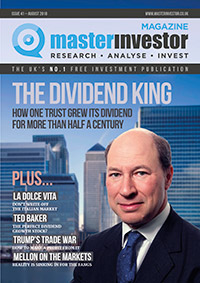How to build the ideal income portfolio – MAGAZINE EXCLUSIVEMAGAZINE EXCLUSIVE

MAGAZINE ARTICLE
This article first appeared in Issue 41 of Master Investor Magazine.
Click here to download the article as a printer-friendly PDF

Get this article and many more – for free! |
The key objective of an income portfolio is that it should generate a sufficient yield for the investor’s current and future needs, without exposing their capital to any unnecessary risks. For most people the easiest way to do this is by putting together a suitably diversified range of income generating funds.
There are many funds and investment companies that pay regular distributions, and by combining four or more into a portfolio it should be possible to achieve a reliable monthly income from a number of different underlying markets and asset classes. When held in an ISA, the income and gains would all be tax-free.
Patrick Connolly, a Certified Financial Planner at Chase de Vere, Independent Financial Advisers, says that the key is to not to consider the funds in isolation, but to look at the overall portfolio in the context of the investor’s circumstances, objectives and attitude to risk. “This means getting the asset allocation right and worrying about the yield on different investments and asset classes later.”
Don’t just look at the current yield
Bonds typically pay a better initial yield than equities, but don’t normally offer much in the way of income or capital growth. It depends where a fund invests, but a higher yield is often indicative of a higher level of risk.
“If investors focus on achieving the maximum level of initial income, this is likely to mean being exposed to higher risk areas and having very limited growth prospects, increasing the danger not only of capital losses but also that the effects of inflation will reduce the real value of their capital and the spending power of their income over time,” explains Connolly.
Equity funds typically pay a lower yield to start with, but have the potential to increase their income over time as the underlying companies grow their earnings and dividends. Investors can spread the risk by putting some of their money into other asset classes, such as fixed interest and commercial property, which both produce a regular income and provide some protection if stock markets fall.
Darius McDermott, MD of Chelsea Financial Services, says that investors need to look at a fund’s ability to grow its dividend over time, which is particularly important in a rising interest rate environment.
“It’s also important to make sure that the fund is well-diversified. The advantage of a fund that invests across different regions is that it will reduce the risk, while opening up a wider set of attractive income opportunities.”
Sustainable income
Sam Murphy, Associate Director, Investment Companies Research at Numis Securities, says that income-conscious investors need to be aware of a fund’s dividend policies, as these can vary significantly between funds and asset classes.
“Some funds focus on capital growth and pay a dividend that will vary with underlying revenues, while others aim to pay a constant, progressive or inflation-linked dividend.”
UK domiciled open-ended funds like OEICs and unit trusts are legally required to distribute all of the income that accrues in the portfolio during the course of their accounting year, so if some of their holdings run into problems and reduce their dividends, the total paid out by the fund could be lower than the year before.
Investment companies have more flexibility as they are allowed to retain up to 15% of their annual income. This is added to their revenue reserves, which can be used to smooth the annual dividend payments from one year to the next, so as to produce a steadily increasing stream of income for their shareholders.
“The UK Equity Income investment company sector has built up average reserves of 0.72 years’ worth of dividends. We believe that funds which have a robust revenue reserve are less likely to cut dividends in tougher times,” explains Murphy.
Another key point to check is the dividend cover, which measures the extent to which a fund’s dividend is supported by income from the underlying portfolio investments. Those funds with a fully covered dividend offer a more sustainable level of income.
It is also important to be aware that a number of funds have attempted to increase their attraction to retail investors through enhancing dividends by paying them from capital profits.The problem with this is that it will exacerbate NAV declines in periods where markets fall.
Low risk income portfolio
Investors who are only willing to tolerate a low level of risk can earn a decent 3.49% yield from a simple four-fund portfolio. The selection that has been put together by Chase de Vere consists of good quality funds, run by proven managers, and aims to provide a diversified exposure to UK and global equities, fixed interest and commercial property, while still producing a reasonable level of income.
Connolly says that Threadneedle UK Equity Income is an ideal core holding that has a very consistent track record. “The managers adopt a contrarian approach, meaning they don’t hold the biggest dividend paying companies if they don’t like them. Not all stocks have to pay a dividend and they are happy to take a long-term approach and ride out any volatility.”
His second selection is Artemis Global Income, which he describes as a fund that consistently outperforms. “The manager does a great job of managing risks by investing in different types of companies, including core holdings that produce stable dividends, growth and cyclical companies, and also special situations opportunities.”
The third holding in the portfolio is Fidelity Extra Income, which benefits from a hugely experienced investment manager, and invests in 60% investment grade bonds and 40% high yield bonds, which means that it can provide good diversification from stock markets and a reasonable yield.
Connolly’s final pick is the M&G Property Portfolio. “This is a very diversified and geographically spread fund that invests in physical bricks and mortar property. It is designed to be a ‘sleep easy’ fund, which focuses on good quality properties that have good lease lengths and low void rates.”
Low risk portfolio selected by Chase de Vere
Fund/Weighting/Yield
Threadneedle UK Equity Income – 25%/3.80%
Artemis Global Income – 25%/3.41%
Fidelity Extra Income – 35%/3.57%
M&G Property Portfolio – 15%/2.94%
Total – 100%/3.49%
Medium risk investment company portfolio
Laith Khalaf, Senior Analyst at Hargreaves Lansdown, says that when looking for income it’s easy to be seduced by the yield on an investment company, but this isn’t a measure that should be taken in isolation.
“The track record of the manager in producing a growing income over the long term is also a key consideration, as is the total return, because it’s very difficult to grow your income if your capital is heading in the opposite direction.”
He has chosen an equally weighted medium risk portfolio of four UK Equity Income investment companies, with the resulting portfolio offering an initial yield of 3.1%.
“Each of these companies is run by a skilful manager with an established long-term track record. A diversity of manager styles should help the portfolio to perform well in a range of market conditions, rather than being overly reliant on one type of stock or sector,” he says.
Medium risk portfolio selected by Hargreaves Lansdown
Investment Company/Weighting/Yield
Edinburgh Investment Trust – 25%/3.9%
Finsbury Growth & Income Trust – 25%/1.9%
Temple Bar Investment Trust – 25%/3.3%
Troy Income & Growth – 25%/3.4%
Total – 100%/3.1%
A more diversified medium risk alternative
Murphy says that JPMorgan Claverhouse (LON:JCH) is an attractive option, with a 3.5% yield and a track record of dividend growth lasting 45 years, backed up by revenue reserves equal to 1.2 years’ worth of dividends.
“The experienced managers focus on large and mid-cap UK equities using a bottom-up, stock-picking approach with an emphasis on quality, momentum and value. Performance has been strong following a strategy review in March 2012 that switched the emphasis to a more fundamentally-driven, higher conviction portfolio within a framework of risk controls that limit relative positions versus the benchmark.”
His second selection is Aberdeen Diversified Income & Growth (LON:ADIG), which seeks to achieve returns of LIBOR+5.5% per annum over rolling five-year periods with a volatility equivalent to 40-50% of equities.
“The aim is to offer a portfolio that is genuinely diversified by asset class, with the managers seeking to manage risk through diversification rather than by investment in low return assets, and allocating capital to areas including Listed Equities, Emerging Market Debt, Property, Infrastructure and Insurance-linked investments.”
Murphy’s other multi-asset pick is Seneca Global Income & Growth (LON:SIGT), which changed its benchmark in July 2017 to CPI plus 6% per annum (currently around 8.8%).
“The portfolio’s equity exposure has been cut from 57% to 54% over the past six months, and is likely to fall further as the manager expects a global bear market in equities in 2019, with a recession in 2020. The fund has a 3.7% yield, which grows at least in line with inflation.”
His final selection is TwentyFour Select Monthly Income (LON:SMIF), which invests in a diversified debt portfolio. The focus is on securities with an “illiquidity premium” that are not suitable for open-ended funds, which fuels the relatively high yield of 6.7%.
Medium risk portfolio selected by Numis Securities
Investment Company/Weighting/Yield
JPMorgan Claverhouse – 25%/3.5%
Aberdeen Diversified Income & Growth – 25%/4.3%
Seneca Global Income & Growth – 25%/3.7%
TwentyFour Select Monthly Income – 25%/6.7%
Total – 100%/4.55%
High risk fund portfolio
McDermott says that investors who are willing to take on more risk can target faster levels of dividend growth and greater capital growth. “Over the long term, it is the dividend-growers that will stand investors in better stead, rather than simply opting for funds with high – and sometimes stagnant – yields.”
The first selection in his four-fund high-risk portfolio is Marlborough Multi-Cap Income, which is yielding 4.16%. It aims to generate an attractive and growing level of dividend income by investing mostly in UK equities, and provides exposure to a diversified 135-stock portfolio.
“Unlike most of its peers, this fund invests mostly in small and medium-sized companies. While this area of the market tends to be higher risk, manager Siddarth Chand Lall believes there is a wider range of hidden gems here, which have further scope to grow their dividends over time,” explains McDermott.
His second pick is Schroder Asian Income, which invests at least 80% of its assets in equities in the Asia Pacific region ex Japan. The £1.3 billion fund has a fairly diversified portfolio of 68 stocks and is yielding 3.59%.
Third on the list is Baillie Gifford Japanese Income Growth, a fairly new fund that has a growth tilt to it. At 1.7% the yield is lower than some of its peers, but McDermott believes that it has significant dividend and capital growth potential.
“A lot of Japanese companies have high levels of cash on their balance sheets yet still don’t yield much, so there is significant scope for long-term dividend growth in this market.”
His final selection is Fidelity Enhanced Income, which has an attractive yield of 6.42%. Managers Michael Clark and David Jehan use covered call options alongside a core of UK dividend-paying equities. This means that the fund could lag during market rallies, but has one of the highest yields in the sector.
High risk portfolio selected by Chelsea Financial Services
Fund/Weighting/Yield
Marlborough Multi-Cap Income – 25%/4.16%
Schroder Asian Income – 25%/3.59%
Baillie Gifford Japanese Income Growth – 25%/1.7%
Fidelity Enhanced Income – 25%/6.42%
Total – 100%/3.97%

|
Comments (0)